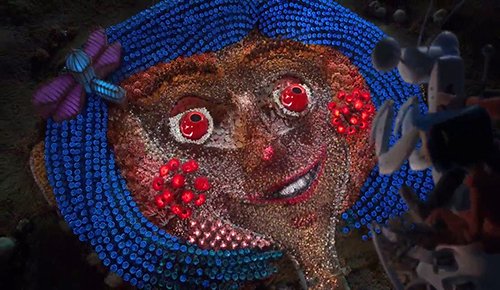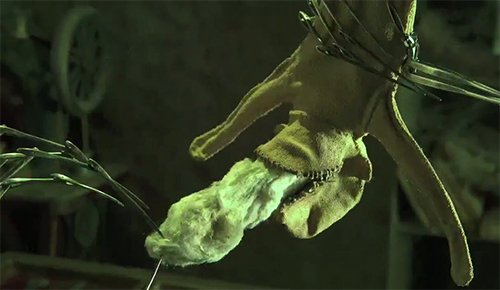Movies and TV
The Hidden Meaning of the Movie “Coraline”

Coraline is a popular stop-motion movie released in 2009. While the film appears to be aimed at young people, Coraline’s imagery tells a hidden story: The programming of a mind control slave at the hands of a sadistic handler. We’ll look at the hidden meaning of the movie Coraline.
Warning: Gigantic spoilers ahead!
Coraline was the first animated movie released by Focus Pictures, the same company that later released 9, another animated movie with a dark underlying meaning (read the article about it here). However, unlike 9, Coraline received rave reviews and almost universal praise for its story and visuals. Part of the movie’s appeal is its simple, child-friendly premise interlaced with twisted imagery and psychological depth. And, for those who know about Mind Control symbolism, the movie goes even deeper: It symbolically depicts the process of programming of a mind control slave at the hands of a manipulative handler (if you have no idea what I’m talking about, read the article Origins and Techniques of Monarch Mind Control).
In fact, the very first scene of the movie is basically a “Mind Control 101” summation of the entire process. It shows a pair of creepy metallic hands transforming an old doll into a new one. If one examines this scene closely, “with eyes to see”, it symbolically (and creepily) depicts how MK slaves are taken, traumatized, and programmed by a handler–represented throughout the movie by a metallic hand.

The creepy hands of an unseen creep are about to get to work on this doll (which represents an MK slave).

Eyes ripped out. As you might know by reading Vigilant Citizen, the removal of eyes is the main symbol representing MK programming.

The doll is then refilled by the handler and made to look like Coraline. The creation of the alter persona is symbolically complete.
The first scene of the movie sums up what will happen during the entire movie: The programming of a young girl by a sadistic handler. Before going into the details of the movie, let’s look at its general premise.
The Premise
Coraline is a little girl who moved into a new house with her parents. She is constantly bored and unhappy and her parents do not give her the attention she wants. While exploring her new house, Coraline finds a small door that leads to an alternate version of her reality where her parents are fun and attentive and where everything is magical and wonderful. In this sense, the premise of Coraline is similar to stories such as The Wizard of Oz, Alice in Wonderland and Labyrinth. All of these movies, including Coraline, follow the same basic blueprint: 1) The protagonist is a young girl that is curious, fearless, resourceful, and not afraid to speak her mind; 2) She is bored with her life and wishes for fun and adventure; 3) She magically enters a world that is strange, but wonderful; 4) She gets “hooked” into the alternate world and doesn’t want to go back to reality.
For this reason, these stories are used as programming tools in actual Mind Control sessions. These storylines encourage slaves who are being tortured to escape the trauma by dissociating from reality and entering an alternate reality (programmed by the handler). By doing so, the brain “disconnects” from the body and the sensation of pain disappears. While watching The Wizard of Oz, slaves are told to “go over the rainbow” and while watching Alice in Wonderland, they must “walk through the looking glass”. Coraline follows a similar script as the protagonist goes through a small door to access the “wonderful” alternate reality. This world is everything Coraline wishes for, but there is one small hiccup: It is fake, created by a sadistic handler to manipulate her. Let’s look at the movie’s protagonist.
Coraline
Later in the movie, Coraline’s father calls her a “twitchy, witchy girl” while singing to her. Throughout the movie, magical, supernatural things happen around her. However, we later discover that these things are traps meant to lead Coraline to her handler. All of these scenes allude to the witchcraft aspect involved in MK programming.
At one point, Wybie gives Coraline a strange gift: A doll that looks just like her.

In MK symbolism, dolls represent the slave’s alter persona. Coraline will call this doll “Little Me”.
Coraline brings this dolls everywhere she goes. However, sometimes, the doll appears to lure Coraline to places where her handler wants her to go: The alternate world or, in MK terms, dissociation.

Coraline finds a small locked door in her house. When her mother unlocks it, the door leads nowhere.

However, at night, Coraline is “magically” lead back to the door and she finds out that it leads to an alternate reality.
The Other World
When Coraline goes through the door, she enters back into her house – but everything is slightly different.

Coraline finds her “Other Mother” who is warmer, more attentive and a better cook than her real mother. Also, she has buttons instead of eyes. The symbolism of buttons instead of eyes is extremely important in this movie: it illustrates that the characters in the alternate world are puppets fabricated by the handler. It is later revealed that the Other Mother is the handler in disguise.
Everything in the Other World is tailor-made to charm Coraline and to fulfill her needs (which are the needs of all children): Receiving attention from parents, having fun and discovering wonderful things. The handler, therefore, knows exactly which “buttons to push” to get a positive response from Coraline. Knowing that Coraline is upset with the disgusting food of her real parents, the Other Mother projects the warm and comforting sight of a mother preparing a home cooked meal for her family.

In the Other World, Coraline’s father created an entire garden that looks like Coraline’s face when seen from above. This is another way to win over Coraline, by tapping in children’s need of being the center of the world. Everything is made especially for her and everything is made to make her feel special.
As expected, Coraline realizes that she likes it better in the Other World. But things get creepy very quickly. While, at first, the movie caters to everything children like, it then turns to everything that scares children (many parents reported that this seemingly child-friendly movie terrified their children and gave them nightmares).
The Other Mother asks Coraline to stay with her forever. To do so, however, Coraline must let the Other Mother sew buttons over her eyes.

Coraline’s other parents proposing her to sew buttons on her face. Notice the two-horned (Baphomet-like) heads in the background. They are prominently lit to emphasize the black magic/occult transformation of the MK process happening in the alternate world. These horned heads are not there in the kitchen of the real world.
The Other Parents ominously call Coraline “our little doll” and tell her that “soon you will see things our way”. Sewing buttons onto her eyes means that she would permanently become the handler’s puppet, who would then, as the movie states, “devour her soul”. In MK terms, she would lose control of her core persona by staying stuck in the dissociative world created by her handler (the equivalent of devouring her soul).
The concept of eyes (and the lack thereof) is extremely important in this movie, as it is in actual MK Programming symbolism. While the occult elite represents itself with the All-Seeing Eye, Mind Control is represented by removing eyes – causing the slave to lose sight of reality.
When Coraline refuses the button deal, the Other Mother gets angry and we see her true form.

The illusion of the Other World is broken. Coraline sees the true form of the other mother, a skeletal spider-like monstrosity. When MK slaves give in to dissociation, the “relief” it causes at first quickly turns into a nightmare.

Coraline is then locked in a room where she finds the ghosts of other kids who became the handler’s slaves. In this scene, the ghosts are hiding one eye while asking Coraline to find their eyes, the only way their souls will be freed.

To find the children ghosts’ missing eyes, Coraline must use a symbolic tool: A triangle with a hole in it. Is this a nod to the All-Seeing in a triangle?
The three ghosts call the Other Mother “Beldam”, which means “ugly, evil-looking old woman”. The word also resembles the term Grand Dame, the title given to important women in the Illuminati mind control system.
“An Illuminati Grande Dame will assist the programmers to insure that the proper script is given to the child and that a psychotic break doesn’t occur causing the victim to lose their mind.”
– Fritz Springmeier, The Illuminati Formula to Create a Mind Control Slave
Not so coincidentally, the Beldam in Coraline basically plays the role of a Grand Dame in mind control programming.
“A close loving bond is needed between a child and the initial abuser so that a clean split is created when the initial mind-splitting trauma is carried out. The clean split occurs when the child is confronted with two irreconcilable opposing viewpoints of someone who is important to them. The child can’t reconcile the two extremely opposite views of the same person, one being a loving caretaker, and the other being the worst kind of abuser. The person the child trusted the most is the person the child fears the most. Some professional therapists have come to realize that this is how the core is split.”
– Ibid.
In Monarch Mind Control, the Grand Dame is one of the three people that assist in the programming of young slaves. Like in Coraline, the Grand Dame is somewhat of a (twisted) mother figure.
“As a child of the Illuminati progressed through its programming, three people had oversight over its programming: its Grande Mother, its Grande Dame, and the Programmer.”
– Ibid.
Throughout the movie, Coraline is told that there is “only one key” that can open and lock the door to the alternate world – and the Beldam desperately wants it. This key represents access to Coraline’s psyche. Either Coraline has control of it or the Beldam does. For this reason, there is “only one key”.
In her quest for freedom, Coraline is not alone. She is helped by a strange character.
The Black Cat
The black cat first appears to Coraline while she’s “water witching” at the beginning of the movie. In European folklore, black cats were believed to be witches’ “familiars”- spirits who aid and protect them while they accomplish their magical work. In Coraline, the black cat basically plays the same role and becomes vital to her succeeding.
While the cat appeared to Coraline in the real world, he also appears in the Other World – and with no buttons on his eyes. Furthermore, when in the Other World, the cat can speak with her. The cat also seems to know a lot about the Beldam and the world she created.

In this scene, the black cat shows Coraline how the Other World is a fake construct created by the Beldam to lure Coraline. In MK terms, the black cat is showing Coraline the confines of the dissociative world.
While the black cat appears to be of great help, he also tends to lead Coraline into Beldam’s traps.

In this scene, the Black Cat leads Coraline back to the portal to the Other World, causing her to dissociate again.
So is the black cat helping or manipulating Coraline? The very end of the movie might provide an answer.
After some adventuring, Coraline saves the ghosts by finding their eyes and destroying Beldam’s constructed world. She then throws the key to the Other World (which represents her psyche) down the magical well she found while water-witching. Coraline then happily goes back to her real world and tries to make the best of real life. Her family organizes a party in their garden – the same garden that was made to look like Coraline in the Other World. As the view of the garden pans out, observant viewers might realize something odd.
While many viewers probably did not notice this almost-subliminal tidbit, it has a heavy meaning. It represents the Beldam imprinting Coraline’s forever – even if she was apparently defeated.
In fact, was the Beldam truly defeated? Was Coraline actually manipulated by the cat? Was throwing the key to her psyche down that well a good move? Can the Beldam now “trigger” Coraline back into her world whenever she needs to? Like in other MK-themed movies (such as Labyrinth), while the final scene of the movie appears to be a celebration, the celebration is dampened by creepy little details that hint that all might not be “well and good”.
Does the cat magically disappear because his job as a guide is complete? Or his job as a programmer is complete? It’s not clear.
In Conclusion
While, at first glance, Coraline appears to be a cautionary tale about appreciating what you’ve got and not falling for things that are too good to be true, the movie’s dark and twisted imagery hints to deeper concepts. As proved by the number of screenshots used in this article, the movie contains a wealth of subtle symbols that tell their own story, one that is laced with occultism and the dark process of Monarch mind control.
The entire movie is based on the symbolism of a menacing hand (representing the handler) manipulating a young girl, luring her into a world created to appeal to her psyche. When Coraline escapes (dissociates) to the Other World, the concept of buttons replacing eyes represent the illusory nature of this world and the blindness of those trapped in it. In the end, Coraline appears to vanquish her foe but, as subtle symbolism suggests, she might have simply done exactly what was expected from her all along.
This movie, which features visuals based on the comforting feel of arts and crafts, nevertheless alludes to mind control, the most sadistic practice known to man. In short, it is deception at its finest. As it is the case with many other works in mass media, Coraline‘s hidden meaning can only be understood by those who have “eyes to see”. Unfortunately, most people still have buttons.
- Hmm 🤔
- Donald Trump attends WEF conference in Davos (January 2020)
- 100% Proof Our Government is Hiding Nephilim Bodies & Are Trying to Bring Back Nimrod/Gilgamesh. Could Nimrod be the Beast of Revelation 17:8-11?
- Tesla's Elon Musk: We're 'Summoning the Demon' with Artificial Intelligence
- Lindsay Mills : Are you aware of occult symbolism in Her pictures..?!?
- LA Fire Attack Map is identical to the LA Smart City Rail Map
- Birds of a feather flock together …
Get an e-mail notification as soon as a new article is published on The Vigilant Citizen.
-

 Movies and TV2 months ago
Movies and TV2 months agoAdrenochrome and Ritual Humiliation: The True Meaning of the Movie “The Substance”
-

 Pics of the Month3 months ago
Pics of the Month3 months agoSymbolic Pics of the Month 10/24
-

 Latest News2 months ago
Latest News2 months agoKamala’s Campaign Was Objectively the Worst in Recent History
-

 Pics of the Month2 months ago
Pics of the Month2 months agoSymbolic Pics of the Month 12/24
-

 Latest News2 months ago
Latest News2 months agoWas the Jake Paul vs Mike Tyson Fight a Humiliation Ritual?
-

 Latest News3 months ago
Latest News3 months agoAn “Urban Opera” in Toulouse Using Massive Machines is Denounced as a Satanic Ritual
-

 Movies and TV1 month ago
Movies and TV1 month agoThe Hidden Meaning of “Smile 2”: It’s About Monarch Mind Control
-

 Latest News1 month ago
Latest News1 month agoIt Was Bound to Happen: Jay-Z Accused of Abusing a 13-Year-Old Girl
























